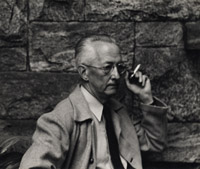Works of Art
- Filters:
- Sort by:
- Results layout:

American, 1883 - 1965
Copy-and-paste citation text:
, “Charles Sheeler,” NGA Online Editions, https://purl.org/nga/collection/constituent/2745 (accessed April 15, 2025).
Export as PDF
| Version | Link |
|---|---|
| Thu Sep 29 00:00:00 EDT 2016 Version |
Born in Philadelphia, Charles Sheeler studied at the Philadelphia School of Industrial Art from 1900 to 1903 and for the following three years at the Pennsylvania Academy of the Fine Arts, primarily under
Around 1910, Sheeler bought a camera and began working as a commercial photographer in Philadelphia. At the same time, he and his friend and fellow artist
During this time, Sheeler traveled often to New York and began developing important relationships with dealers and collectors there and exhibiting in group shows, including the 1913 Armory Show. He was introduced to
Throughout the 1920s, Sheeler achieved both critical and financial success as a commercial photographer. In 1926 he was hired by
In 1931, the dealer Edith Halpert offered Sheeler exclusive representation at her Downtown Gallery in New York. She encouraged him to curtail his work in photography and focus his artistic energies on painting instead. Following a solo show at the Downtown Gallery, Sheeler promptly resigned from Condé Nast and turned his artistic attention toward oil, conté crayon, and tempera.
Beginning in the late 1920s, Sheeler’s paintings and drawings appeared in important exhibitions at the Museum of Modern Art, the Arts Club of Chicago, and the Whitney Museum of American Art, among others. His work entered the collections of many of these institutions, as well as those of important collectors of American modernism, including the Arensbergs, Duncan Phillips, and Ferdinand Howland.
Sheeler’s paintings from this time, many of which take inspiration from the artist’s own photographs, use the imagery of America’s rural past and industrialized present to explore modernist ideas of perception and representation. His carefully detailed and highly finished images of factories, farmhouses, and furniture were simultaneously geometric and abstract, alienated and historicized, mechanical and evocative. Central to this artistic practice was a continued intellectual and artistic exploration of the intersection between painting and photography and the influences the two mediums could have on each other.
This approach positioned Sheeler as a central figure in a group of American artists that came to be known as the precisionists (they were initially known as the “immaculates”). The precisionists, whose ranks included
In the late 1940s, Sheeler’s painting style underwent a significant change, moving away from photographic realism in favor of more abstract compositions that reflect the artist’s interest in photomontage. In these late works, Sheeler layered different photographic negatives of a single subject (often architectural) and translated this image onto a canvas. In 1959 he suffered a stroke that left him unable to paint or take photographs. Sheeler died six years later in Dobbs Ferry, New York, from a second stroke.